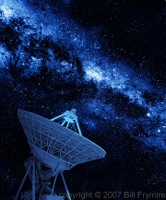Difference between revisions of "Telecommunication"
(Created page with 'File:lighterstill.jpgright|frame *[http://en.wikipedia.org/wiki/1932 1932] ==Definition== *1: [[com...') |
m (Text replacement - "http://" to "https://") |
||
| Line 1: | Line 1: | ||
[[File:lighterstill.jpg]][[File:Radio-telescope-satellite-stars-milky-way-telecommunication.jpg|right|frame]] | [[File:lighterstill.jpg]][[File:Radio-telescope-satellite-stars-milky-way-telecommunication.jpg|right|frame]] | ||
| − | *[ | + | *[https://en.wikipedia.org/wiki/1932 1932] |
==Definition== | ==Definition== | ||
*1: [[communication]] at a distance (as by telephone) | *1: [[communication]] at a distance (as by telephone) | ||
| Line 8: | Line 8: | ||
'''Telecommunication''' is [[communication]] at a distance by [[technological]] means, particularly through electrical signals or [[electromagnetic]] waves. Due to the many different technologies involved, the word is often used in a plural form, as ''telecommunications''. | '''Telecommunication''' is [[communication]] at a distance by [[technological]] means, particularly through electrical signals or [[electromagnetic]] waves. Due to the many different technologies involved, the word is often used in a plural form, as ''telecommunications''. | ||
| − | Early telecommunication technologies included [[visual]] signals, such as [[beacons]], [ | + | Early telecommunication technologies included [[visual]] signals, such as [[beacons]], [https://en.wikipedia.org/wiki/Smoke_signal smoke signals], [https://en.wikipedia.org/wiki/Semaphore_line semaphore telegraphs], signal flags, and optical [https://en.wikipedia.org/wiki/Heliograph heliographs]. Other examples of pre-modern telecommunications include audio messages such as coded [https://en.wikipedia.org/wiki/Drum_(communication) drumbeats], lung-blown horns, and loud whistles. [[Electrical]] and [[electromagnetic]] telecommunication [[technologies]] include telegraph, telephone, and teleprinter, networks, [[radio]], [https://en.wikipedia.org/wiki/Microwave_transmission microwave transmission], fiber optics, communications satellites and the [[Internet]]. |
| − | A [[revolution]] in [ | + | A [[revolution]] in [https://en.wikipedia.org/wiki/Wireless_communication wireless telecommunications] began in the 1900s with pioneering developments in [[radio]] communications by [https://en.wikipedia.org/wiki/Guglielmo_Marconi Guglielmo Marconi]. Marconi won the Nobel Prize in Physics in 1909 for his efforts. Other highly notable pioneering inventors and developers in the field of electrical and electronic telecommunications include [https://en.wikipedia.org/wiki/Charles_Wheatstone Charles Wheatstone] and [https://en.wikipedia.org/wiki/Samuel_F.B._Morse Samuel Morse] (telegraph), [https://en.wikipedia.org/wiki/Alexander_Graham_Bell Alexander Graham Bell] (telephone), [https://en.wikipedia.org/wiki/Edwin_Armstrong Edwin Armstrong], and [https://en.wikipedia.org/wiki/Lee_de_Forest Lee de Forest] (radio), as well as [https://en.wikipedia.org/wiki/John_Logie_Baird John Logie Baird] and [https://en.wikipedia.org/wiki/Philo_Farnsworth Philo Farnsworth] (television). |
| − | The world's effective capacity to exchange [[information]] through two-way telecommunication networks grew from 281 [ | + | The world's effective capacity to exchange [[information]] through two-way telecommunication networks grew from 281 [https://en.wikipedia.org/wiki/Petabytes petabytes] of (optimally compressed) information in 1986, to 471 petabytes in 1993, to 2.2 (optimally compressed) [https://en.wikipedia.org/wiki/Exabytes exabytes] in 2000, and to 65 (optimally compressed) exabytes in 2007. This is the informational equivalent of two newspaper pages per person per day in 1986, and six entire newspapers per person per day by 2007. Given this [[growth]], telecommunications play an increasingly important role in the world economy and the global telecommunications industry was about a $4.7 trillion sector in 2012. The service revenue of the global telecommunications industry was estimated to be $1.5 trillion in 2010, corresponding to 2.4% of the world’s [https://en.wikipedia.org/wiki/Gross_domestic_product gross domestic product] (GDP).[https://en.wikipedia.org/wiki/Telecommunication] |
[[Category: Physics]] | [[Category: Physics]] | ||
Latest revision as of 02:36, 13 December 2020
Definition
- 1: communication at a distance (as by telephone)
- 2: a system that converts acoustic vibrations to electrical signals in order to transmit sound, typically voices, over a distance using wire or radio.
Description
Telecommunication is communication at a distance by technological means, particularly through electrical signals or electromagnetic waves. Due to the many different technologies involved, the word is often used in a plural form, as telecommunications.
Early telecommunication technologies included visual signals, such as beacons, smoke signals, semaphore telegraphs, signal flags, and optical heliographs. Other examples of pre-modern telecommunications include audio messages such as coded drumbeats, lung-blown horns, and loud whistles. Electrical and electromagnetic telecommunication technologies include telegraph, telephone, and teleprinter, networks, radio, microwave transmission, fiber optics, communications satellites and the Internet.
A revolution in wireless telecommunications began in the 1900s with pioneering developments in radio communications by Guglielmo Marconi. Marconi won the Nobel Prize in Physics in 1909 for his efforts. Other highly notable pioneering inventors and developers in the field of electrical and electronic telecommunications include Charles Wheatstone and Samuel Morse (telegraph), Alexander Graham Bell (telephone), Edwin Armstrong, and Lee de Forest (radio), as well as John Logie Baird and Philo Farnsworth (television).
The world's effective capacity to exchange information through two-way telecommunication networks grew from 281 petabytes of (optimally compressed) information in 1986, to 471 petabytes in 1993, to 2.2 (optimally compressed) exabytes in 2000, and to 65 (optimally compressed) exabytes in 2007. This is the informational equivalent of two newspaper pages per person per day in 1986, and six entire newspapers per person per day by 2007. Given this growth, telecommunications play an increasingly important role in the world economy and the global telecommunications industry was about a $4.7 trillion sector in 2012. The service revenue of the global telecommunications industry was estimated to be $1.5 trillion in 2010, corresponding to 2.4% of the world’s gross domestic product (GDP).[1]
